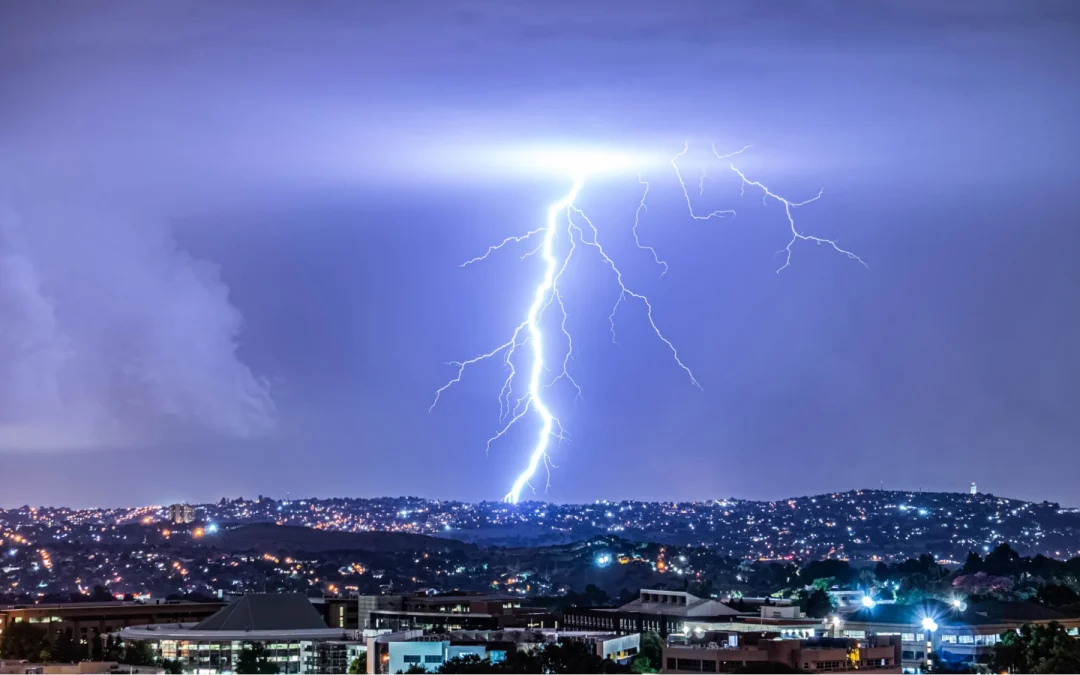Lightning strikes may seem like a rare occurrence, but when they do hit, they can cause serious damage to your equipment, disrupt operations, and skyrocket repair costs. Whether you’re a facility owner, safety director, or operations manager, protecting your assets from lightning-induced damage is essential, but it’s not just about installing a lightning protection system (LPS) and calling it a day.
In fact, regular lightning protection inspections are crucial to ensure your system is working as intended and meeting the required standards. Not only does this help prevent costly outages and equipment loss, but it can also keep your insurance premiums in check and help you stay compliant with codes like NFPA 780 and IEC 62305.
In this blog, Shaw Consulting Services walks you through why lightning protection system inspections should be part of your ongoing maintenance plan, what to look for during inspections, and how regular checks can save your facility from expensive headaches down the road.
1. Lightning Protection Systems: Not a Set-and-Forget Solution
When you install a lightning protection system (LPS), it’s easy to think your work is done. However, just like any other safety system, lightning protection requires periodic checks to ensure it’s still up to code and functioning as it should. Over time, components like air terminals, down conductors, and grounding systems can degrade due to weather, wear, or corrosion.
A lightning protection inspection helps catch these issues before they become a major problem. Regular inspections will give you a clear understanding of the condition of your system and allow you to schedule maintenance before damage occurs, reducing the risk of an expensive, unexpected repair.
2. Complying with NFPA 780 and IEC 62305
One of the main reasons lightning protection inspections are so important is to stay compliant with industry standards like NFPA 780 (Standard for the Installation of Lightning Protection Systems) and IEC 62305 (International Lightning Protection Standard). These standards outline the proper installation, maintenance, and testing requirements for lightning protection systems.
For businesses and facilities, compliance isn’t just about following best practices—it’s a regulatory necessity. Inspections help demonstrate that you’re meeting those standards, reducing liability, and protecting employees, equipment, and your property.
3. Surge Protection and Grounding Verification
It’s not just about preventing direct lightning strikes. Indirect effects like electrical surge damage can cause a serious impact on sensitive equipment, especially in critical facilities like data centers, hospitals, and industrial plants. Surge protection devices (SPDs) are designed to absorb these surges, but over time, they can degrade or malfunction if not properly tested and maintained.
A proper lightning protection inspection includes surge protection device testing, grounding and bonding verification, and down conductor resistance testing to ensure that every part of your LPS is in working order. Ensuring your grounding system is up to standard is vital for minimizing the risk of electrical faults and ensuring the safety of your operations.
4. Lightning Risk Assessments: Why You Need Annual Inspections
Did you know that annual lightning risk assessments can help you better understand the vulnerabilities in your facility’s infrastructure? An annual lightning risk assessment takes into account factors like location, building height, and the presence of critical systems to determine your facility’s risk profile.
With regular inspections and risk assessments, you’re not just keeping your lightning protection system up to snuff—you’re proactively mitigating the risks of lightning-induced damage. This can help avoid the high repair costs and downtime that come with an unprotected facility during a storm.
5. Reducing Insurance Costs with Verified Inspections
Your insurance provider likely requires proof of a lightning protection system inspection as part of their risk assessment process. If you can’t demonstrate that your LPS is properly maintained and compliant with UL lightning protection certification or other industry standards, you could face higher premiums—or worse, your policy could be canceled.
By ensuring that you have regular inspections and up-to-date lightning protection system upgrades, you show your insurer that you’re taking proactive steps to reduce risk. This can ultimately result in lower insurance premiums and a stronger risk profile for your business.
6. Key Areas Covered in Lightning Protection Inspections
Here are some of the most important components that a professional inspection will cover:
- Air Terminal Maintenance: Checking the air terminals (roofs, spires) for wear, corrosion, and proper positioning.
- Down Conductor Resistance Testing: Ensuring conductors can safely carry the lightning charge to the ground.
- Lightning Arrestor Performance Audit: Evaluating the condition of lightning arrestors to ensure they’re functioning correctly.
- Building Earthing System Audit: Verifying that your grounding system meets electrical safety standards.
- Flashover Risk Analysis Services: Identifying areas that may pose flashover risks during a strike.
These areas are critical to maintaining a functioning lightning protection system and ensuring your building is safe.
7. The Importance of Preventive Maintenance for Lightning Protection Systems
Preventive maintenance for LPS is often overlooked, but it’s crucial for extending the lifespan of your system and ensuring safety. Just like any other safety equipment, your lightning protection system needs care and attention to ensure it remains effective. Simple issues like lightning conductor corrosion or damaged conductors can lead to significant risks if left unchecked.
A preventive maintenance checklist for lightning protection systems can ensure that every critical part of your system—like down conductors, air terminals, and surge protection devices—is functioning correctly. This checklist should be updated annually as part of your regular maintenance cycle.
8. Preparing for Thunderstorms: Stay Ahead of the Storm
In areas like Atlanta, where severe thunderstorms and lightning are common, staying ahead of the weather is key. A thunderstorm preparedness plan should include lightning protection system inspections to ensure your facility is ready for any storm that may come through.
This plan should detail inspection schedules, emergency procedures for lightning strikes, and guidelines for handling power surges. Being proactive can help avoid downtime and safeguard your operations when you need it most.
Protect Your Assets with Regular Lightning Protection Inspections
When it comes to safeguarding your facility, equipment, and employees from the dangers of lightning, regular lightning protection inspections are non-negotiable. These inspections not only help you stay compliant with critical safety standards like NFPA 780 and IEC 62305, but they also reduce the risk of lightning-induced damage, lower your insurance premiums, and ensure the continuous, safe operation of your facility.
Shaw Consulting Services is here to help you maintain a strong and reliable lightning protection system. Contact us today to schedule your next inspection or to learn more about how we can assist with your lightning protection and risk mitigation efforts.

